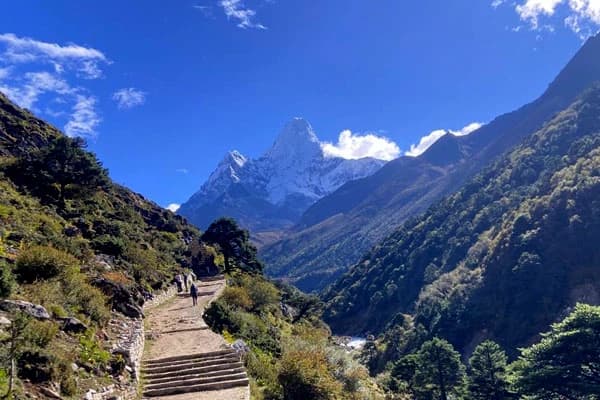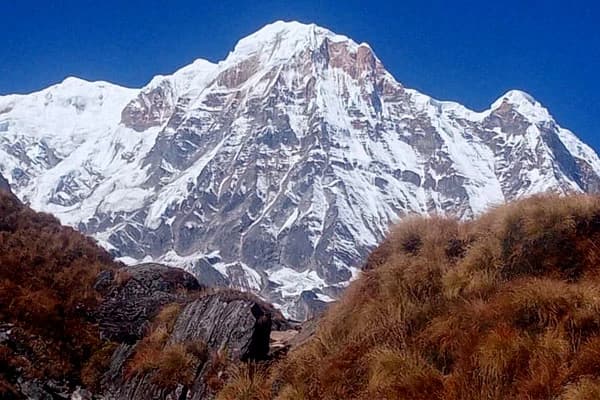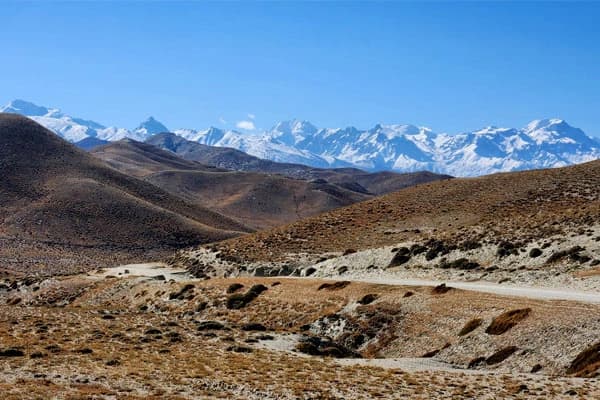Understanding the Risk during the trek to Annapurna Base Camp (ABC)
Now, before you think about packing for the Annapurna region treks in Nepal, consider these pitfalls that may occur during this trek. I don't intend to frighten you, but just knowing these dangers is a step toward better preparing yourself to trek in the Himalayas, so here are must-knows.
Avalanche Risk
Avalanches do occur in the higher mountains, especially those with heavy snowfall. So yes, avalanches can occur on this trek, but do not panic yet. Most of the trail, luckily, is fairly safe from avalanches. The risky places are generally between Hinku Cave and Deurali, and those landslides are mainly experienced during winter and early spring. The local guides know about these routes and keep you safe. They check conditions daily and change the routes if necessary. Most trekkers never even witness an avalanche, yet trekking with experienced guides who understand mountain weather conditions is a wise decision.
Terrain Challenges
The trail is not always smooth and easy-going like simple Poon Hill Trek; hence, you will encounter various rocky paths, wobbly suspension bridges and quite leg-shaking climbs await you in between some steep sections. Some areas, however, become dangerously slippery in rain or snow. Some portions are dangerously slippery when it rains or snows. Stone stairways, too, become a bit uneven and tricky, especially when tired. But thousands of trekkers walk these same paths every year. Think slow and steady, wear good boots, and even consider trekking poles. Mind your steps and don’t rush, especially in those tricky bits of the trail.
Altitude and Physical Demands
This is possibly the biggest challenge for most during the ABC trek. Annapurna Base Camp stands tall at 4,130 meters, where the air has less oxygen in the thin air. Your body needs some time to adjust to it. Some get a headache, nausea, or feel unwell, others hardly sleep well; worse, it becomes a serious case of altitude sickness. There is more, it is also about 5 to 7 hours of walking daily for up to 10 to 12 days, or 7 days if you do the Annapurna Base Camp Short Trek. Your legs will be tired, and that backpack will seem heavier as the days pass. But no worries; you don't have to be a marathon runner. Stay fit and listen to your body.
Weather And Seasonal Challenges
The mountain weather changes quickly and can either be your friend or your foe. From sparkling sunshine in one moment to a thunderous downpour or snowstorm in the next. Monsoon rains bring muddy and slippery trails that require careful negotiation. Winter can be a cause for altitude sickness because of heavy snowfall and freezing temperatures at high altitudes. Spring carries unpredictability of storms, but they do not last for long. The best time for climbing is generally October-November and March-May, but even then, warm clothes along with rain gear are must-haves. Mountain weather does not follow any rules; thus, always be ready for anything. In case you have checked forecasts, do not completely rely on them.
Wildlife Encounters in the Forest Trail
You might just have encounters with a wild animal or two in your Annapurna Trek, but most of them will stay harmless. Sometimes there have been reported sightings of bears, Himalayan thar, or snow leopards, but these creatures usually shy away from humans. Of course, it is dangerous when an animal like a bear or a snake happens to cross your path unless you know what to do. Most of the animals you get to sight are simply majestic and make the trek worthwhile. Just please don't feed them, seal all food properly, and walk through dense forest areas with sharp noise.
Limited Accessibility
If a mishap occurs up there in the mountains, things get rough in acquiring help. Since there is no road to Annapurna Base Camp (ABC), much like the remote Nar Phu Valley Trek, an emergency exit ranks mainly as helicopter one-way flights, which hazardous weather may be suspended for days. The cell phone signal is weak, if not missing, throughout most places. No roads exist for a car trail; therefore, you must hike or mount a mule. It can take some time to get help in an emergency. The closest hospital lies back in Pokhara, many helicopter flight hours distant. Hence, travel insurance with coverage for helicopter rescue becomes a must.
How To Be Prepared For the Safe ABC Trek?
Now that you are aware of what can go wrong, let's make sure it never happens to you. Preparation is far more than buying gear and booking flights. The better prepared you are, the more fun the whole thing will be and, of course, the safer you will be on the mountain.
Build Physical Stamina And Endurance
- Start with 30-minute walks up and down the streets of your neighborhood. Increase the time gradually to 60-90 minutes. This helps in building leg strength for those steep ascent mountain paths.
- Load a backpack with 10-15 kg and walk around with it. Your shoulders and back need to get accustomed to the weight they will be carrying for hours every day.
- This mimics walking uphill and downhill all day long, something quite different from what you would do on a normal day. At least your knees and thighs will thank you later on.
- Cardio workouts such as swimming, cycling, or running actually help to build the heart and lung strength needed at higher altitudes. Start for 20-30 mins.
- Simple exercises such as planks, crunches, and lower back extensions prevent injuries. A strong core makes sure that the spine is supported while the individual carries a heavy backpack for hours.
- Try yoga, stand on one leg, or walk along mounds of earth. Good balance is essential to avoid twisting an ankle on narrow paths or falling dangerously.
- Just build yourself up to a 4-6-hour walk without any stops. Start with shorter walks, longer by 30 minutes every week, until you find long-distance walking comfortable.
Gradual Ascent, Know Your Pace
This is the golden rule of high-altitude trekking is to not to rush up the mountain. Your body needs time to make more red blood cells and adjust to less oxygen. Most people who get altitude sickness go up too fast. Plan to gain only 300 to 500 meters of sleeping altitude per day above 3,000 meters. It is not a race; the mountains will be there tomorrow. Going up at your own comfortable speed is one way to avoid altitude sickness. It's better to spend an extra day resting and getting accustomed than to rush and feel bad.
Maintain A Healthy Diet
What you eat before and during the trek to Annapurna Base Camp matters a lot. It would be best to start eating foods rich in iron, like spinach and red meat, at least two weeks before departure, so your blood can carry more oxygen. During the trek, a high-carbohydrate diet of rice and pasta is great energy fodder. Drink a lot of water-three to four liters at a minimum-but make sure it's filtered and safe. Do not have any alcoholic drinks or may caffeine in excess, as these will aggravate the symptoms of altitude sickness. You should also avoid foods that are spicy, oily, or heavy because these irritate the stomach.
Prepare Mentally And Soulfully
Your mind is just as important as your body on this trek. There will be some really hard days, when you are tired and cold and maybe a little homesick. Practice some meditation or deep breaths even before you go. Those work wonders when you are feeling anxious or overwhelmed. Speak to others who have completed the trek as their stories and advice will build your confidence and excitement in equal measure. If you feel worried, then talking with friends or a guide can help. Remember, anything that uses an already calm and happy mind will make the trek easier and more enjoyable.
Pack Appropriate Gear And Equipment
The right stuff to pack can make your trek or break it. Go for good hiking boots; remember to break them in well before you go. Pack some clothing layers: Mountain weather changes fast. Keep a warm sleeping bag; one rated for low temperatures would be great. And do not forget your first aid kit, headlamp, and trekking poles either. It is possible to purchase or rent out some of the gear in Kathmandu, and it is of varied quality. A checklist is invaluable, so check your gear twice. Missing something important can be very dangerous and costly to replace on the mountain. The proper gear keeps you safe and comfortable on the trail.
The Safest Seasons to trek for the base camp of Annapurna
Timing is paramount when safe trekking in the Annapurna Region, and choosing the wrong season may mean facing dangerous weather, closed trails, or just miserable conditions that would ruin the whole experience. The best and safest seasons are autumn that is from September to November and the spring months from March to May. Post-monsoon, the weather during autumn is just amazing and stable. The sky is mainly clear, giving the most vivid mountain views and the daytime temperatures are mild, growing cold with nightfall. There is almost a certain possibility that there will be no showers or snowfall along the way, so the trails remain dry and easy to navigate. The peak season usually makes these trails a bit crowded, yet the crowds also support safety.
Spring is equally safe and warm; rhododendron flowers everywhere beautify the trekking route immensely. Days are long and warm as in autumn, while in the afternoons, clouds may obscure the mountain views but just for a very short period. Trail conditions are dry and secure so that the enchanting view can be enjoyed fully.
Avoid trekking in the monsoon season (June to August) when heavy rainfall would make pathways slippery and landslides block the trails although he upper region is a rain shadow area near Upper Mustang. In winter (December to February), the higher altitudes get extremely cold with heavy snowfall, thereby increasing the risk of avalanches. The snow-covered trails become slippery and hard to navigate safely. Choosing the right time of the year makes your venture a beneficial endeavor to prevent any occurrences of bad weather or dangerous trail conditions.
Symptoms And Prevention Of Acute Mountain Sickness
The journey to the high Himalayas is not easy and you know what makes it harder? The altitude. The Annapurna region Trek extends to 4,130 meters where altitude creates challenges like Acute Mountain Sickness (AMS).
Symptoms
- Headache
- Nausea or vomiting
- Dizziness or lightheadedness
- Fatigue or weakness
- Shortness of breath
- Loss of appetite
- Trouble sleeping
Prevention
- Don't rush up the trail. Your body needs to adjust slowly so increase your sleeping elevation in daily steps of 300-500 meters.
- You need to consume 3-4 liters of water each day, whether or not you feel thirsty. The dry mountain environment takes away moisture from your body at an increased rate. Stay hydrated!
- Schedule a day of rest every time you climb 1,000 meters higher in elevation. Use this day to let your body get used to high altitude but continue taking smaller trips to new heights
- Avoid taking alcohol and too much caffeine. Your physical functions related to oxygen distribution in your body lose efficiency when you consume these items.
- Practice "climb high, sleep low". You should climb at higher altitudes during daylight hours while returning to lower sleeping areas.
- Stop at every location to monitor your oxygen level with an oximeter and notify your guide about discomfort and any oxygen readings below average.
- Report any headache, dizziness or stomach sickness immediately because these are warning signs of altitude sickness. Inform your guide or companions immediately to assist you.
- Descend if symptoms worsen. Moving to a lower altitude serves as the most effective treatment for altitude sickness. Stop your ascent if your physical condition worsens significantly.
- Talk to your doctor about taking Diamox as a prevention method before heading to high altitudes.
Importance Of Hiring A Local Guide For Safety
Should you trek to ABC alone or hire a guide? This question comes up very frequently and rightfully so, because having a local guide is one of the smartest safety decisions you can make. Local guides consider these mountains as though they were in their backyard! They know the weather patterns, the altitude sickness symptoms, and of course when you must turn around because it is no longer safe to be in those mountains. They have traveled hundreds of times through these trails and can immediately evaluate the situation for problems that would escape a layperson. If you get sick or injured, they will be able to help you quickly.
The guide can make your whole trekking experience much more enjoyable. They know the best tea-houses and help you negotiate prices and communicate with locals. Apart from sharing stories of mountain culture, they'll show you things you'd otherwise take for granted. A lot of guides are trained in first aid skills and carry emergency equipment.
Yes, the guide costs a little extra, but these costs are like paying for a mountain expert and safety companion in one. For the very first Annapurna trek, especially when you have not been a seasoned hiker, a trekking guide is not just helpful; he is a lifesaver.
Essential Gear And Equipment for Safe Trek
- Instead of packing large items, try bundling your clothes. Include a warm base layer, a mid-layer of fleece and a waterproof/windproof outer jacket in your clothes.
- Well-detailed maps and a compass are both important, even if your phone has a GPS. There are times when technology doesn’t work, batteries run out and phones break.
- Choose waterproof trekking boots that provide high ankle support for your trek. Start wearing your boots at home for two or three weeks in advance so they break in properly.
- Layers of cold-weather clothing should include thermal underwear along with hiking pants and a fleece jacket but you will need a down jacket and outer waterproof layer too.
- You need a sleeping bag rated below -10°C (14°F) as the blankets in teahouses do not provide adequate protection from the cold in winter months
- Carry a 2-3 liter capacity drinking water bottle and keep water purification tablets or purchase a filter for your water before your journey..
- Always carry your headlamp and some extra batteries when you are out hiking. Power outages happen frequently and you could need the bathroom in the middle of the night.
- Bring a power bank so you can charge your phone, camera and similar devices. Power isn’t always available when you stop and a few teahouses make you pay for electricity.
Top 10 Tips For Safe Navigation During The Trail
- Follow the trail that looks to get the most foot traffic. Many side trails may lead to villages, water, or dead ends. The main ABC trail is generally wider and has several prayer flags and stone cairns to mark the way.
- There are lots of signs along the ABC trail, in both English and Nepali, pointing towards "Annapurna Base Camp" or "ABC". Take pictures of important signs for future reference. Some signs indicate distances and walking times to other villages.
- Cell service in the mountains is very inconsistent, so you must download offline maps before you begin trekking. Apps like Maps.Me or AllTrails will work without internet and show the hiking trails. Mark important waypoints around, such as the starting point, tea houses, and campsites.
- Be sure to leave your tea house early, around 7-8 AM. That way, you can be safely at your destination using daylight. The mountain weather deteriorates as the afternoon approaches, and making your way in the darkness can be hazardous.
- There is safety in numbers on these mountain trails. They can help you if you are lost, hurt, or sick, or they can go find help. Walk with other trekkers you meet on the way, join an organized trek group, or hire a guide.
- Never feel shy to ask for help! Locals know these trails better than anyone else, and briefly, fellow trekkers may be coming from the same direction you are heading.
- Memorize the names of key villages on your route, major landmarks like rivers, bridges, and mountain peaks. This will help in requesting directions or calling for help when needed. Know which village comes before yours and after your position.
- A whistle can cut through fog more than a shout can, and it is useful when you're too tired to yell. Three short blasts, a universally recognized distress signal. If you are lost or hurt, give three sharp blasts every few minutes and wait for possible responses.
- Heavy fog, snow, or rain renders trails invisible and extremely dangerous. If you can't see farther than 20-30 meters, then it is time to consider waiting it out or turning back. Seek shelter and wait for improvement in the weather conditions.
- Write the emergency phone numbers, your hotel address, and trek permit details on a waterproof piece of paper with your guiding company phone number, local police, and helicopter rescue service numbers.
Is ABC Trek Safe To Do?
Now, for the most important question, the Annapurna Base Camp trekking, in fact, is it safe? An honest response would be yes, but only with some stipulations. Every year, thousands and thousands do it without any serious problem. It is much safer than the Everest Base Camp Trek or any sort of technical mountaineering. The trail is mostly well-marked, with good infrastructure such as tea houses and rescue options, and it does not require any special climbing ability. You walk on established paths that are commonly used by local people.
Still, it is no day walk as you'll be confronted with challenges that mountains pose, unlike altitude, rapid changes in weather, and tough terrain. Some people do get injured or sick; that's when the difference between a safe trek and a dangerous trek really comes into play. Preparation and decision-making; being physically fit, well prepared, hiring a guide, and a little bit of common sense put you well in the safe path to having an amazing experience to remember. The majority of problems arise when people rush, disregard warning signs, or attempt treks that are beyond their capacity.
ABC Trek is safer than some of the Annapurna region treks that ascend to higher altitudes, such as theAnnapurna Circuit Trail and Manaslu Circuit Trek. It's also more accessible than some fairly remote treks, such as the Mardi Himal and Khopra Ridge Trek. At the end, preparation is the way to go!
Final say: Conclusion
Trekking to Annapurna Base Camp is safe for most people who are well prepared and trek smart. There are certainly risks like altitude and weather challenges coming from terrain or obstinate obstacles; hence, such risks can be reasonably avoided with a good plan and using common sense. These extra precautions help reduce any risk involved in ABC.
If ABC seems a bit too tough for your initial trip to Nepal, then there are more accessible options such as Short Mardi Himal Trek, or a shorter Ghorepani Poon Hill Trek. These would give you mountain exposure without putting you at risk for high-altitude sickness. From those, you will be geared up for ABC or perhaps even the longer Mardi Himal and Annapurna Base Camp Trek.
Contact us, Destination Himalaya Trek and Expedition, for your safe and fun trek to Annapurna now!
FAQs
Should I hire a local guide?
A local guide is a must, especially for first-time trekkers. They are familiar with routes and weather patterns and identify early symptoms of altitude sickness before they become severe. They manage emergencies and generally allow for safer and more enjoyable trekking.
What are the risk possibilities during the trek?
The primary risks are altitude sickness, weather changes, difficult terrain, avalanches on parts of the trail, getting lost and in some of the parts which are difficult to navigate.
Are solo treks safe on the ABC trail?
It is possible but not advisable for beginners to trek alone. If you get hurt or sick, there will be no immediate help, so either join a group or hire a guide.
What to do in case of an emergency?
Stay calm, and inform the guide. In case of a serious injury or severe altitude sickness, call for helicopter rescue right away. Use a satellite communicator or move around to find cell service, and notify your insurance company and local authorities.
How to trek ABC safely in the winter season?
Winter trekking has to be taken seriously with preparation and experience. Trek with companies like Destination Himalaya Treks and Expedition, which specialize in safety even under winter conditions. These are the essential elements the company ensures for you: heavy winter gear, experienced guides, and flexible schedules that may change due to weather conditions.
Is the Annapurna Base Camp Trek safe to do with kids?
Children above 10 years can undertake this trek if supported properly and if they are physically fit. Children are usually more sensitive to altitude sickness and may not be able to endure long walking days, yet with a steady pace, it is possible.
Does this trek have any age limits?
There is no such thing as an age limit; however, you must be physically capable of walking for 5-7 hours daily for 10-12 days. Children and the elderly have completed this trek. Fitness counts much more compared to age.




